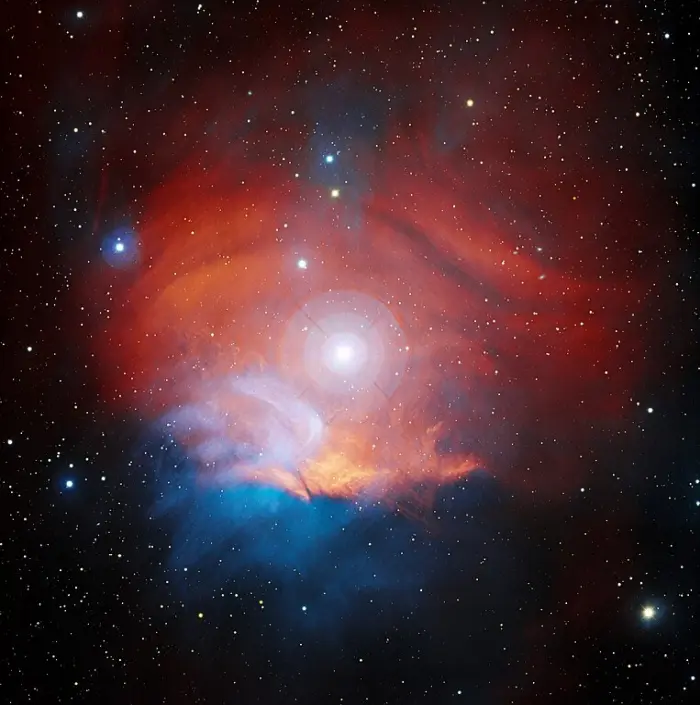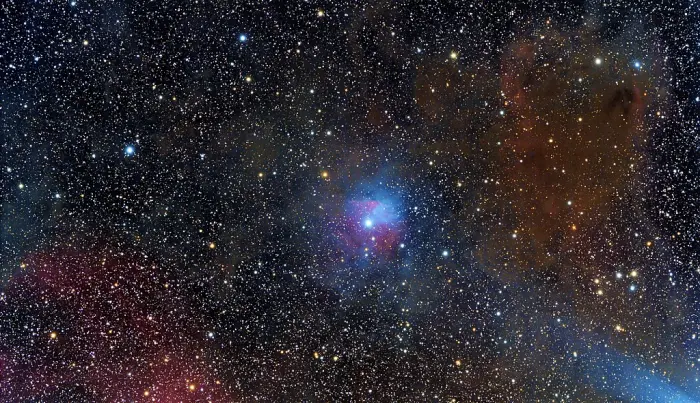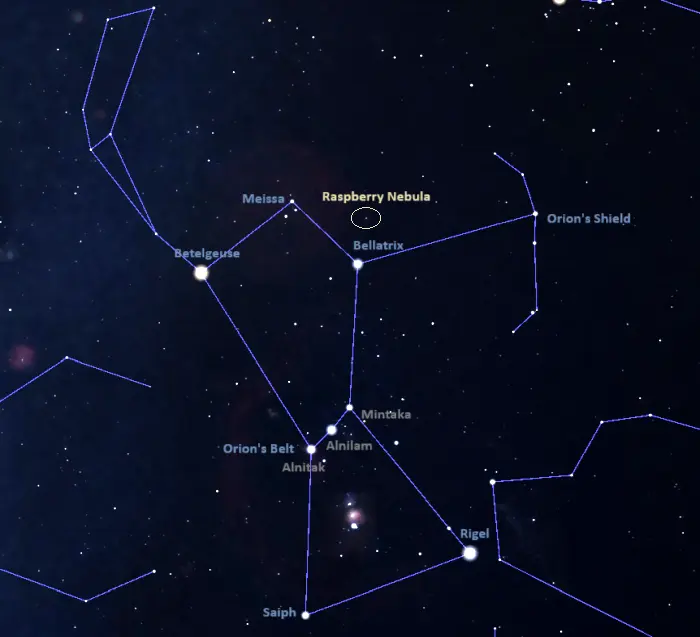The Raspberry Nebula is a nebula located in the northern part of the constellation Orion (the Hunter). It consists of the emission nebula Sh2-263 and the reflection nebula vdB 38. The nebula appears near the bright Bellatrix at Orion’s shoulder in the sky.
The Raspberry Nebula shines partly by emission – the portion that appears red in images emits its own light – and partly by reflection, reflecting the blue light of a hot nearby star. The reflection nebula has an apparent magnitude of 5.77.
The patch of dark nebulosity that obscures some of the nebula’s light is catalogued as LDN 1588 or Barnard 223. The dark nebula B223 has an apparent size of about 8 arcminutes.

Observing the night sky has never been so delightful as with this image of LBN 867, the Raspberry Nebula. Captured here by the Nicholas U. Mayall 4-meter Telescope using the Mosaic-3 detector at Kitt Peak National Observatory (KPNO), a Program of NSF’s NOIRLab, this nebula is located in the constellation Orion. LBN 867’s overall structure, though, is more like an onion than a raspberry: it hosts three different celestial objects in one! The characteristic red bloom of LBN 867 is an emission nebula. It glows as a result of the ionization of hydrogen gas by the light from the star HD 34989. From the center of the image, this main sequence star shines prominently, though it is about as bright as the planet Uranus as seen from Earth. The last object is hidden in plain sight. Notice the subtle bluish glow around HD 34989? This is the reflection nebula vdB 38, which reflects the blue-white light of its host star off local interstellar dust. Combined, the nebulae and star become a cosmic treat for any keen astronomer. Credit: KPNO/NOIRLab/NSD/AURA/T.A. Rector (University of Alaska Anchorage/NSF’s NOIRLab) Image processing: T.A. Rector (University of Alaska Anchorage/NSF’s NOIRLab), M. Zamani (NSF’s NOIRLab) & D. de Martin (NSF’s NOIRLab) (CC BY 4.0)
The emission nebula Sh2-263 has an apparent size of about 15 arcminutes, corresponding to a physical size of about 10 light-years.
The brightest star appearing in the region of the Raspberry Nebula is HD 34989. The supernova candidate is a hot, blue B-type main sequence star with a mass 12.1 times that of the Sun.
HD 34989 shines at magnitude 5.80 from a distance of 1,700 light-years and is faintly visible to the unaided eye in good conditions. It has a surface temperature of 24,838 K and a luminosity of 1,508 Suns. The star is only around 8 million years old. The Simbad database lists it as a member of the young open cluster Collinder 69, also known as the Lambda Orionis Cluster.
HD 34989 is responsible for ionizing the HII region Sh2-263. The star’s ultraviolet light ionizes a significant part of the surrounding cloud.
Only exceptionally massive stars can release sufficient energy to excite the nearby clouds and make them emit their own light. Cooler stars do not emit enough radiation to ionize hydrogen, but their light can be reflected off the nearby gas and dust, making the clouds glow as reflection nebulae.
The region of ionized atomic hydrogen is also catalogued as LBN 867. The entire nebula is sometimes also called the Strawberry Nebula. It has the catalogue designations Cederblad 44, DG 53, and Magakian 97.

The Raspberry Nebula is in the center. (Sh2-263 is the red emission nebula and vdB 38 is the blue reflection nebula.) The central star is HD 34989. To the right is Sh2-265 and the lower left shows a section of the Lambda Orionis Ring Sh2-264. The blue light from the star Bellatrix shines from the lower right. Image credit: Wikimedia Commons/Keesscherer (CC BY-SA 4.0)
Location
The Raspberry Nebula lies in the region between Orion’s head, marked by Meissa (Lambda Orionis), and shoulder, marked by Bellatrix (Gamma Orionis). It can be found by extending a line from Alnilam (Epsilon Orionis), the middle star of Orion’s Belt, through Bellatrix. It appears 2.2 degrees north-northwest of Bellatrix.
The Raspberry Nebula appears in the same area as the Angelfish Nebula (Sh2-264), a large molecular cloud also known as the Lambda Orionis Ring. The star HD 34989 lies just outside the Ring. The fainter emission nebula Sh2-265 appears in the same wide field of view as Sh2-263.
The best time of the year to observe the Raspberry Nebula and other deep sky objects in Orion is during the northern hemisphere winter, when the celestial Hunter appears higher above the horizon in the early evening.
At declination +08° 23’ 57’’, the nebula is visible from virtually anywhere for at least part of the year.

The location of the Raspberry Nebula in Orion, image: Stellarium